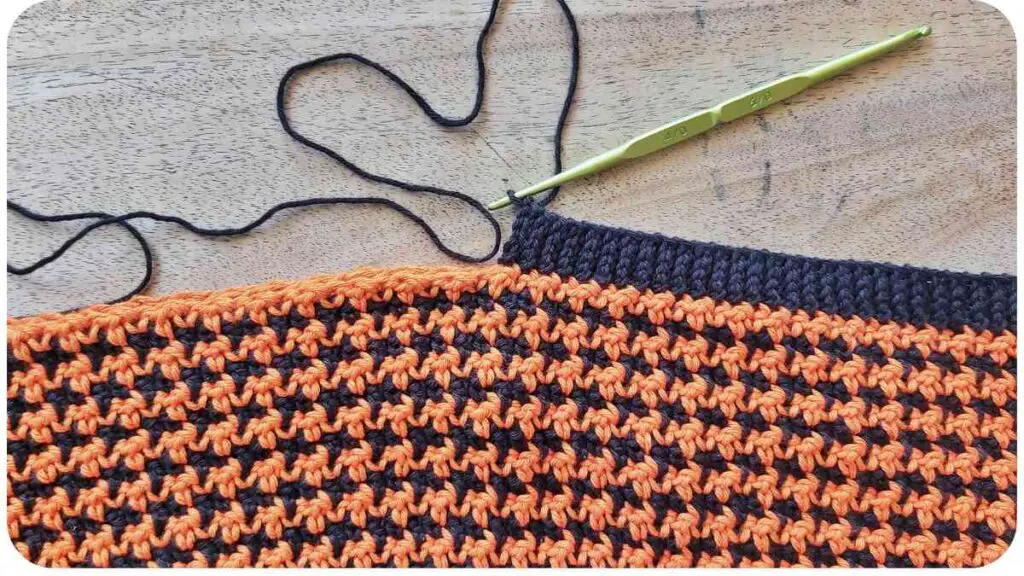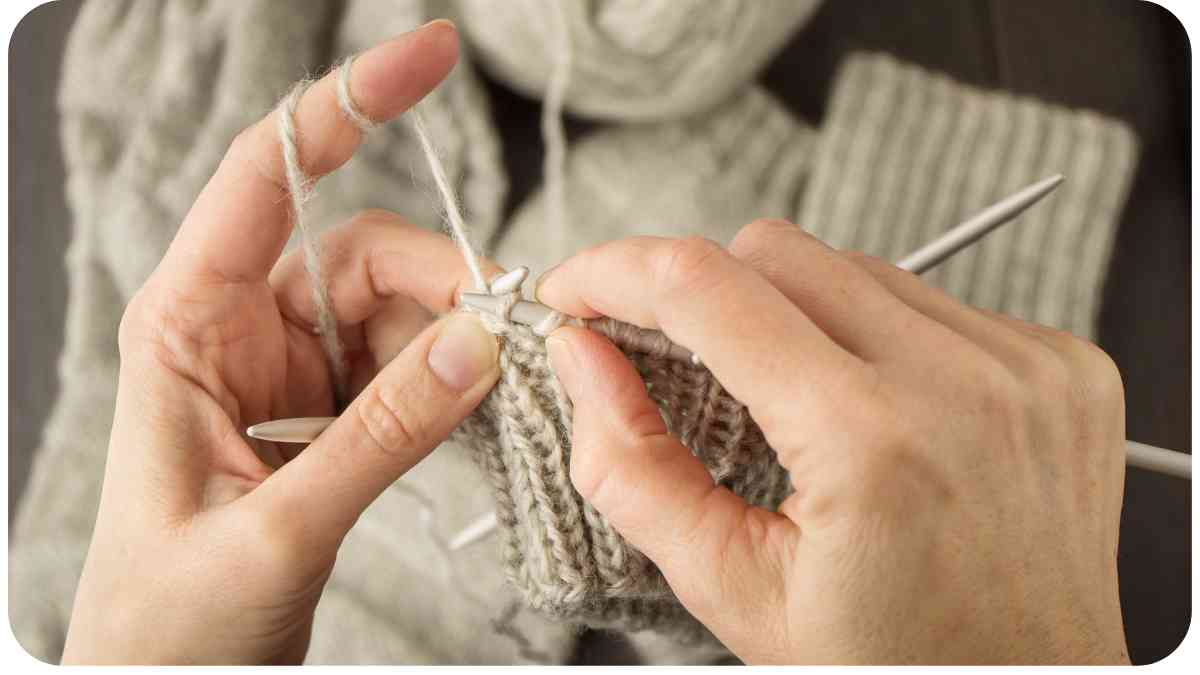Welcome to the world of knitting, where creativity and craftsmanship combine to create beautiful projects. Whether you’re a beginner or an experienced knitter, understanding gauge is crucial to achieving the desired outcome of your knitting project.
In this article, we will explore what gauge is, how to determine it, interpret the results, and make necessary adjustments. By the end of this article, you will have a solid understanding of gauge and be able to tackle any knitting project with confidence.
| Takeaways |
|---|
| Understanding gauge is crucial for successful knitting projects. |
| Gauge refers to the number of stitches and rows per inch in a knitted fabric. |
| Measure gauge accurately by creating a gauge swatch and washing/blocking it before measuring. |
| Deviations from the pattern gauge may require adjustments in needle size, yarn weight, or stitch pattern. |
| Achieving the correct gauge ensures your finished project will have the desired dimensions and fit. |
| Common gauge issues include too tight, too loose, or uneven gauge, which can be addressed through various techniques. |
| Accurate gauge measurement is essential for consistent results and avoiding sizing inconsistencies. |
| Resources available provide additional guidance and tips for understanding and adjusting knitting gauge. |
| Practice, experimentation, and personal experience are key to mastering gauge and achieving knitting success. |
| Enjoy the process of knitting and embrace gauge as a helpful tool in creating beautiful projects. |
2. What is Gauge in Knitting?
Gauge refers to the number of stitches and rows per inch in a knitted fabric. It is an essential measurement that ensures your finished project matches the dimensions stated in the pattern. Every knitter has a unique tension or knitting style, resulting in variations in stitch size and overall gauge. Understanding and achieving the correct gauge is crucial for ensuring your project turns out as expected.
To measure gauge accurately, you need to consider various factors such as needle size, yarn weight, and stitch pattern. These elements work together to create a specific fabric density, drape, and overall appearance in your finished project.
Dive into the world of sweater knitting with valuable insights on patterns, techniques, and tips. Explore the ultimate guide for crafting cozy and stylish knitted sweaters.
3. Determining Your Gauge
To determine your gauge, you will need a few tools and follow a step-by-step process.
3.1. Tools Required
- Knitting needles (recommended size mentioned in the pattern)
- Yarn (same weight as mentioned in the pattern)
- Gauge swatch (a small sample of knitting)
3.2. Calculating Gauge
Start by casting on the number of stitches mentioned in the pattern instructions, plus a few extra stitches for accuracy. Work on your swatch for a few inches using the specified stitch pattern. Once complete, measure the number of stitches within a 4-inch section, both horizontally and vertically. This measurement will give you the stitch gauge and row gauge, respectively.
3.3. Swatching
Swatching is a vital step in determining your gauge. It helps you understand how your tension and knitting style affect your stitch and row count. Ensure your swatch is large enough to encompass multiple stitches and rows. This will minimize any errors caused by measuring an insufficient sample size.
Elevate your crochet projects by mastering the art of yarn selection. Learn essential tips and considerations in the yarn selection process to enhance the beauty and functionality of your crochet creations.
3.4. Washing and Blocking
After knitting your swatch, it’s important to wash and block it before measuring the gauge. This step simulates how your finished project will behave after washing. Wet blocking involves gently washing the swatch, allowing it to soak, and then laying it flat to dry. Blocking ensures the stitches settle into their natural shape and may affect the final gauge.
4. Interpreting Your Gauge
Once you have measured your gauge, it’s essential to interpret the results correctly.
4.1. Importance of Gauge
Matching the gauge specified in the pattern ensures your finished project will have the correct dimensions, fit, and overall appearance. Deviations in gauge can lead to projects that are too large, too small, or have a different drape than intended.
4.2. Deviations from Pattern Gauge

If your gauge matches the one mentioned in the pattern, you can confidently proceed with the instructions. However, if your gauge differs, it’s crucial to make adjustments.
- Smaller Gauge: If your stitches are smaller than the pattern gauge, you may need larger needles or thicker yarn to achieve the desired size and drape.
- Larger Gauge: If your stitches are larger than the pattern gauge, you may need smaller needles or thinner yarn to obtain the correct size and drape.
Uncover the significance of blocking in knitting and discover how it transforms your projects. Delve into the details of blocking techniques to achieve a polished and professional finish for your knitted masterpieces.
5. Adjusting Your Gauge
When faced with deviations from the pattern gauge, there are several ways to make adjustments and achieve the desired results.
5.1. Changing Needle Sizes
If your gauge is too large, try switching to smaller needles. Conversely, if your gauge is too small, using larger needles can help achieve the desired gauge. Remember to create another swatch after changing needle sizes to evaluate the new gauge.
5.2. Changing Yarn Weights
Another way to adjust gauge is by changing the yarn weight. Using a lighter weight yarn can help you achieve more stitches per inch, while a heavier weight yarn may result in fewer stitches per inch. Keep in mind that changing the yarn weight can also impact the overall appearance and drape of your project.
5.3. Changing Stitch Patterns
The stitch pattern you choose can also affect your gauge. Some stitch patterns naturally create a more compact or looser fabric. If your gauge is off and you’re set on using a particular stitch pattern, try experimenting with different knitting styles or techniques to achieve the desired gauge.
Embark on your crochet journey by mastering the fundamental techniques. Explore the essential basics to unleash your creativity and craft beautiful crochet artworks with confidence and skill.
5.4. Altered Fit or Drape
Adjusting your gauge may impact the fit or drape of your finished project. Consider the desired outcome and consult the pattern instructions to understand how gauge adjustments may affect the final result. Making note of any potential changes in fit or drape is important to avoid any surprises when completing your project.
6. Common Gauge Issues
Understanding and troubleshooting common gauge issues can help you prevent future mistakes. Here are some common gauge problems and their possible solutions:
6.1. Too Tight Gauge
If your gauge is too tight, meaning you have more stitches per inch than required, using larger needles or looser tension can help alleviate the issue. Practice knitting with a more relaxed grip and take breaks to prevent excessive tension.
Elevate your knitting projects with the enchanting art of colorwork. Learn how to add dimension through colorwork and infuse vibrancy and personality into your knitted creations, making them truly stand out.
6.2. Too Loose Gauge
If your gauge is too loose, resulting in fewer stitches per inch, try using smaller needles or applying a firmer tension while knitting. It may take some practice to adjust your knitting style and find the right balance of tension.
6.3. Uneven Gauge
An uneven gauge refers to inconsistencies within your knitting, resulting in sections where the stitches are tighter or looser. This can be caused by variations in tension or stitch manipulation. Pay attention to your knitting technique and practice maintaining a consistent tension throughout your project.
7. Tips for Accurate Gauge Measurement
To ensure the most accurate gauge measurement:
- Use a ruler or measuring tape with clearly marked measurements.
- Measure your gauge across a larger section of stitches and rows to minimize errors caused by individual miscounts.
- Take several measurements and calculate an average to account for any minor discrepancies.
- Wash and block your swatch before measuring the gauge, as this more closely simulates the final fabric behavior.
8. Conclusion
Understanding and determining gauge in knitting is paramount to achieving the desired outcome in your projects. We have explored how to calculate gauge, interpret the results, and make necessary adjustments.
By following these guidelines and considering personal experience and expertise, you can confidently take on any knitting project knowing that your finished piece will be a reflection of your skill and creativity.
Further Reading
Here are some additional resources to further enhance your understanding of knitting gauge:
- Knitting Knowledge: Knitting Knowledge provides a comprehensive guide to understanding knitting gauge. This resource covers various aspects of gauge, including how to measure it accurately and troubleshoot common issues.
- Sarah Maker: Sarah Maker’s website offers a detailed article on knitting gauge. Learn more about the importance of gauge in achieving successful knitting projects and gain insights on how to interpret and adjust gauge for optimum results.
- Craftsy: Craftsy offers an informative post that delves into the intricacies of knitting gauge. Explore tips for swatching, measuring gauge, and making necessary adjustments to ensure your projects turn out beautifully.
FAQs
Here are some frequently asked questions about knitting gauge:
How do I measure gauge accurately?
To measure gauge accurately, cast on the recommended number of stitches and work a few inches in the specified stitch pattern. After washing and blocking the swatch, use a ruler or measuring tape to count the number of stitches and rows within a 4-inch section.
Can I use any yarn for my knitting projects?
It’s important to choose a yarn that matches the weight specified in the pattern to achieve the intended gauge. Substituting a different weight yarn can lead to variations in stitch size and overall fabric density.
What do I do if my gauge doesn’t match the pattern?
If your gauge differs from the pattern, you can make necessary adjustments by changing needle sizes, yarn weights, or stitch patterns. Experiment with these variables and create a new swatch to test the revised gauge.
Why is gauge essential in knitting?
Gauge ensures that your finished project will have the correct dimensions, fit, and appearance as intended by the pattern designer. It helps you achieve consistent results and avoid potential sizing or shape inconsistencies.
How can I fix an uneven gauge?
An uneven gauge often occurs due to variations in tension or stitch manipulation. Paying attention to maintaining a consistent tension and practicing even knitting can help improve an uneven gauge. Consider adjusting your technique or grip to achieve more uniform stitches.

My name is Hellen James, and I’m a crochet and knitting expert. I’ve been crocheting since I was just a kid, but I started taking it seriously when I realized that it was a great way to de-stress and relax. Now that I have kids of my own, I love teaching them how to do it too!

